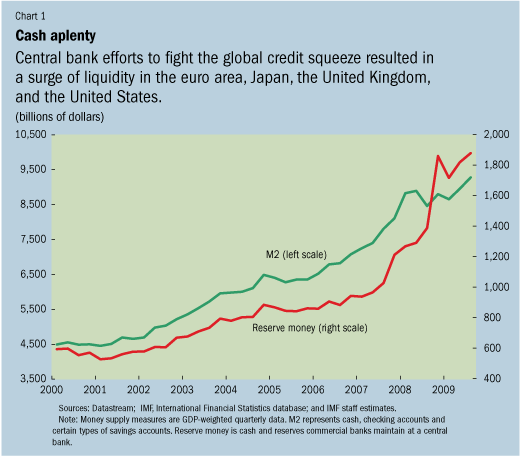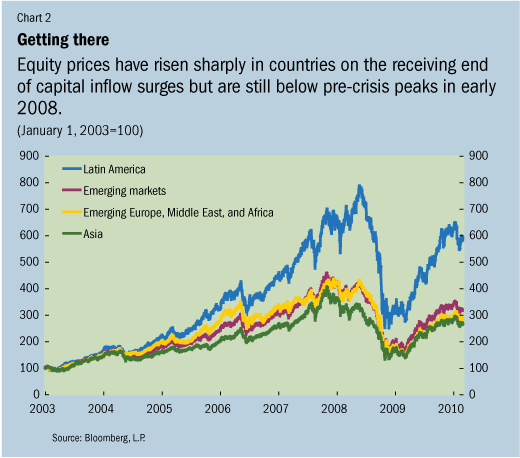
Typical street scene in Santa Ana, El Salvador. (Photo: iStock)
IMF Survey: Capital Surges Can Be Difficult For Recipient Countries
April 13, 2010
- Abundant global liquidity can pose problems for some countries
- Macroeconomic policies can be used to manage capital inflow surges
- Capital control may complement other policies
The unprecedented liquidity created by countries to fight the economic crisis could create problems for policymakers in some advanced and emerging market economies with relatively strong growth prospects and higher interest rates, the International Monetary Fund said in a new report.

Liquidity created to fight global economic crisis could create problems for policymakers, IMF report says (photo: Yuriko Nakao/Reuters).
GLOBAL FINANCIAL STABILITY REPORT
The longer countries where the crisis originated maintain their low interest rate policies, the more likely it is that inflow surges will continue as investors will seek higher returns in stronger economies.
In a special analysis that is part of its latest Global Financial Stability Report, the IMF discussed some of the after-effects of the global financial crisis—a surge in capital inflows arising from ramped up money supply and liquidity in the advanced economies meant to ease the effects of sharply curtailed credit. (see Chart 1).

The IMF also released two other analyses April 13. One looked at efforts to deal with institutions that are so large and interconnected that they pose systemic risks and the other examined how to deal with the systemic risks caused by the explosion in trading in over-the-counter derivatives.
The unconventional monetary policy measures undertaken during the crisis helped stabilize the financial system and supported the return to growth. However, the current highly liquid conditions and the resulting surge in capital flows pose policy challenges to a number of countries where the crisis did not originate.
The primary risk is rising inflation expectations in the domestic goods and assets markets, although, so far, asset valuations in economies experiencing capital inflows have not yet returned to pre-crisis levels (see Chart 2). Sudden surges in capital inflows also raise concerns about vulnerabilities of those countries to abrupt stops or reversals in those flows once the global liquidity is unwound.
Effects of global liquidity expansion
Although the benefits of capital inflows are manifold, sudden inflow surges may be lead to inflation and asset price bubbles. An analysis of the movement of abundant global liquidity and the accompanying surge in capital flows finds strong links with rising asset prices, such as equity returns, a decline in real interest rates, and official reserve accumulation in economies with comparatively higher interest rates and a stronger growth outlook.

While domestic monetary conditions are a factor, the influence of global liquidity can be more than domestic liquidity. The study also finds that more flexible exchange rates can dampen the pressure on local equity prices and real interest rates.
Countries’ policy responses
There are a number of potential policy responses to mitigate risks related to capital inflow surges, which include
• More flexible exchange rate policies, especially when the exchange rate is undervalued. A floating exchange rate provides a natural buffer against surges in global liquidity by making it more expensive for foreign investors to purchase assets and, as a result, reducing valuation pressures on domestic assets.
• Official reserve accumulation. By adding to reserves governments, in effect, hold on to some of the capital inflows.
• Reducing interest rates, if the inflation outlook permits, to lessen the attraction for investors seeking higher returns.
• Tightening fiscal policy when the overall macroeconomic policy stance is too loose.
• Reinforcing prudential regulation in the financial system.
If conditions allow, liberalization of controls on capital outflows can prove useful as then the pressures on domestic asset markets are partially relieved by domestic investors buying assets abroad. The appropriate policy mix will depend on country-specific conditions.
When these policy measures are not sufficient and capital inflow surges are likely to be temporary, controls on capital inflows may have a role as a complement to the policy mix. However, more permanent increases in inflows tend to stem from fundamental factors and require more deep-seated economic adjustment.
While they can be useful in selected circumstances, the overall evidence on the effectiveness of capital controls is mixed. There is some indication that controls can keep capital inside the country longer—although they do not reduce the volume of inflows—and create greater room for the central bank to conduct an independent monetary policy
Even if capital controls prove useful for individual countries in dealing with capital inflow surges, they may lead to adverse effects on other countries. The adoption of inflow controls in one country, if effective, can divert capital flows to its peers, prompting the introduction of capital controls in those countries as well. A widespread reliance on capital controls may delay necessary macroeconomic adjustments in individual countries and, in the current environment, prevent the global rebalancing of demand, which would hinder global recovery and growth.


